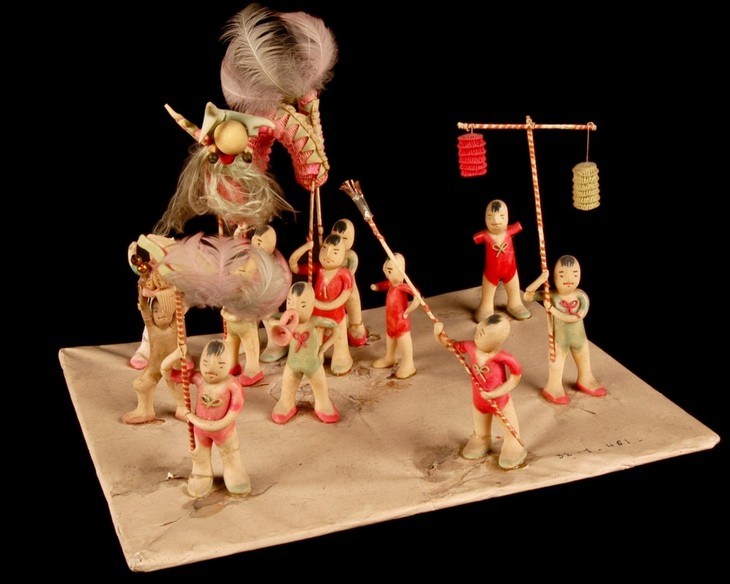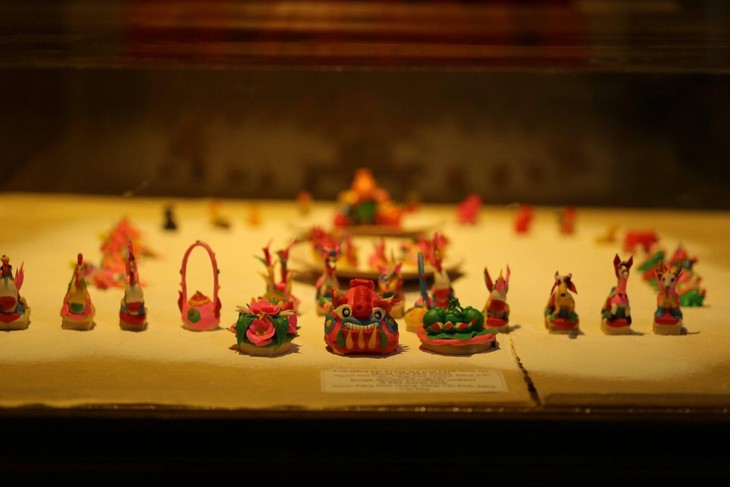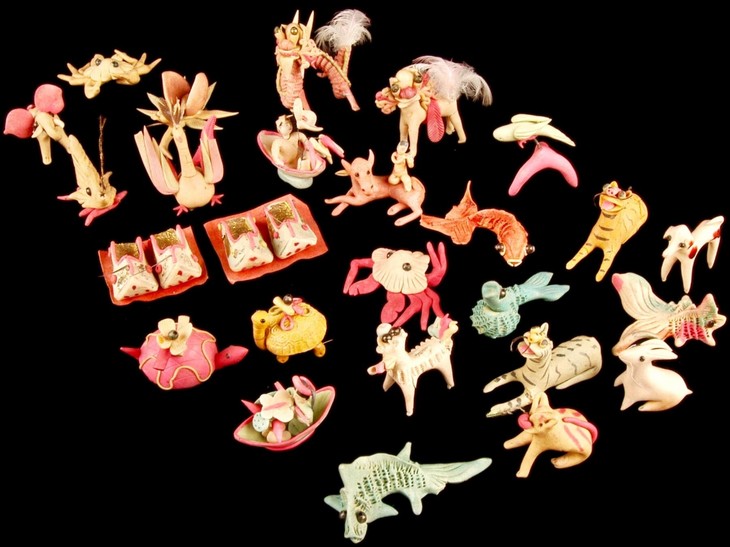(VOVWORLD) - Traditional powder figurines (To he) are a type of Vietnamese folk toy, which are small, colorful figurines made from glutinous rice powder. In the past, tò he were made and sold only on the occasion of festivals, particularly during Tet - the traditional lunar New Year festival - and the Mid-Autumn festival which are the two favorite festivals of Vietnamese children. Nowadays, the toys can be found at most festivals in Vietnam and in public places like parks or gardens thanks to artisans and cultural researchers' efforts to preserve it.
 There are three different ways of making toy figurines by craftsmen in three different areas: Xuan La village, Phu Xuyen district, Dong Xuan and Pho Khach in Hanoi’s Old Quarter. There are three different ways of making toy figurines by craftsmen in three different areas: Xuan La village, Phu Xuyen district, Dong Xuan and Pho Khach in Hanoi’s Old Quarter. |
To he (toy figurines) seems to fall into oblivion in this contemporary time. In recent years, Vietnamese artisans and cultural researchers have made great efforts to revive this kind of traditional toy. Cultural researcher Trinh Bach and craftsman Dang Van Hau are among those who have made the toy more popular in the modern life. They have done a lot of research, remade the toys, and displayed them on Hang Ma street where a wide range of modern toys are on sale for the Mid-autumn Festival. Craftsman Dang Van Hau said: “We make To he in a traditional way. It is a hard work to make the same models of traditional toy figurines”.
It is not easy to restore the craft of making the toy figurines with a few artisans doing the work while many related historical documents have been lost. For a long time, Vietnamese folk toys were dominated by modern, imported toys. But craftsman Dang Van Hau and cultural researcher Trinh Bach do not give up. Trinh Bach said: “In 2017, Hau met a To he making artisan in Dong Xuan market in Hanoi. She gave us a set of tools to make them. The toy cannot be made totally by hand only. You need tools to make it”.
 In Xuan La village, Phu Xuyen district, toy figurines are made of glutinous rice powder dyed with cooked natural materials. The rice powder is steamed to become shiny (Photo: the Quai Branly Museum, France) In Xuan La village, Phu Xuyen district, toy figurines are made of glutinous rice powder dyed with cooked natural materials. The rice powder is steamed to become shiny (Photo: the Quai Branly Museum, France) |
There are three different ways of making toy figurines by craftsmen in three different areas. In Xuan La village, Phu Xuyen district on the outskirt of Hanoi, toy figurines are made of glutinous rice powder dyed with cooked natural materials. The rice powder is steamed to become shiny. After that, craftsmen shape the dough into edible figurines such as trees, animals, flowers or characters from folk stories.
Meanwhile, craftsmen in Hang Ma, Hang Luoc, Hang Duong, and Dong Xuan street in Hanoi’s Old Quarter make toy figurines from glutinous powder mixed with colors, and then polish them to keep them for longer time. The toys can be in the shapes of cattle like horses, buffaloes, goats, pigs, fish, shrimp, elephants, tigers, or fruits. Some toys even depict people’s daily lives like a buffalo herding boy or children performing lion dances.
Another style of toy figurines called Pho Khach toy figurine was previously created by Chinese craftsmen in the Old Quarter streets of Hang Buom and Ma May. The toy figurines look more sophisticated and mainly depict four sacred animals and characters in Chinese history, stories or legends. In the 1960s, the traditional powder figurines of Pho Khach were placed in a stick which made it easier for the toys to be dried and then later became a folk toy called “To he”. Craftsman Dang Van Hau talked about the 3 styles of making powder figurines: “There are differences between the three styles. The styles of Phu Xuyen toy figurines are quite flexible and diverse. Each artisan has his or her way of making the toys. But, there was one thing in common. Phu Xuyen toy figurines are kept in bamboo sticks or rings. Dong Xuan toy figurines have darker colors as the powder was not steamed”.
 (Photo: the Quai Branly Museum, France) (Photo: the Quai Branly Museum, France) |
Traditional toy figurines are not just popular folk toys, they also serve as religious objects. The figurines are considered a charm to protect the children from bad spirits. Toy figurines in the shape of five-fruit trays, horses, or embroidered shoes are used as offerings at the temples or pagodas. The images of young ladies in red, green or white dresses standing on boats or living in the mountains represent the Four Mother Goddesses of the Mother Goddess worshipping religion.
Due to the domination of modern, imported toys, traditional toy figurines in Hanoi were once fell into oblivion. In recent years, craftsmen and cultural researchers like Trinh Bach and Dang Van Hau have made it fresh.